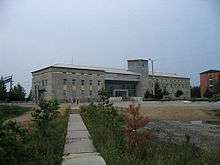Fevralsk
Coordinates: 52°27′07″N 130°53′10″E / 52.45194°N 130.88611°E

Fevralsk (Russian: Февра́льск) is an urban locality (a work settlement) in Selemdzhinsky District of Amur Oblast, Russia, located between the Selemdzha River and its tributary the Byssa, about 340 kilometers (210 mi) northeast of Blagoveshchensk, the oblast's administrative center, and 204 kilometers (127 mi) southwest of Ekimchan, the administrative center of the district. Population: 5,128 (2010 Census);[1] 4,690 (2002 Census);[2] 8,816 (1989 Census).[3]
History
The village of Fevralskoye (Russian: Февра́льское) was founded in February 1896 by settlers from Central Russia; the name was derived from the Russian word "февраль" (fevral), meaning "February".
In 1974, the village became one of the most important support bases for construction of the Baikal-Amur Mainline (BAM). The station and the settlement were built by workers from Krasnoyarsk Krai; as part of the construction of the BAM, various sections and towns along the route were placed under the patronage of Komsomol brigades from different parts of the Soviet Union.
In 1982, the village was given its current name and was granted urban-type settlement status. Regular rail traffic on the BAM section from Tynda to Komsomolsk-on-Amur began in 1989. Many inhabitants left the settlement after completion of the rail line. However, in contrast to most other settlements along the BAM, the population has once again begun to increase, with a population of 4,904 according to the 2006 estimates.
Economy
Logging is conducted in the area around Fevralsk, mainly for export to nearby China.
Transportation
Fevralsk is an important station on the BAM, located 3,017 kilometers (1,875 mi) from Tayshet, and is the biggest settlement on the over 1,000 km-long section between Tynda and Novy Urgal. The rail line crosses the Selemdzha and the Byssa Rivers close to the settlement, over two bridges which are, respectively, 700-meter (2,300 ft) and 200-meter (660 ft) long. A 144-kilometer (89 mi) long branch line is being built north to the Ogodzha coal fields.
References
- ↑ Russian Federal State Statistics Service (2011). "Всероссийская перепись населения 2010 года. Том 1" [2010 All-Russian Population Census, vol. 1]. Всероссийская перепись населения 2010 года (2010 All-Russia Population Census) (in Russian). Federal State Statistics Service. Retrieved June 29, 2012.
- ↑ Russian Federal State Statistics Service (May 21, 2004). "Численность населения России, субъектов Российской Федерации в составе федеральных округов, районов, городских поселений, сельских населённых пунктов – районных центров и сельских населённых пунктов с населением 3 тысячи и более человек" [Population of Russia, Its Federal Districts, Federal Subjects, Districts, Urban Localities, Rural Localities—Administrative Centers, and Rural Localities with Population of Over 3,000] (XLS). Всероссийская перепись населения 2002 года [All-Russia Population Census of 2002] (in Russian). Retrieved August 9, 2014.
- ↑ Demoscope Weekly (1989). "Всесоюзная перепись населения 1989 г. Численность наличного населения союзных и автономных республик, автономных областей и округов, краёв, областей, районов, городских поселений и сёл-райцентров" [All Union Population Census of 1989: Present Population of Union and Autonomous Republics, Autonomous Oblasts and Okrugs, Krais, Oblasts, Districts, Urban Settlements, and Villages Serving as District Administrative Centers]. Всесоюзная перепись населения 1989 года [All-Union Population Census of 1989] (in Russian). Институт демографии Национального исследовательского университета: Высшая школа экономики [Institute of Demography at the National Research University: Higher School of Economics]. Retrieved August 9, 2014.